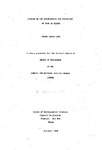STUDIES ON THE DISTRIBUTION AND PHYSIOLOGY OF LEAD IN PLANTS
| dc.contributor.author | LANE, STUART DAVID | |
| dc.contributor.other | School of Geography, Earth and Environmental Sciences | en_US |
| dc.date.accessioned | 2013-11-19T11:49:38Z | |
| dc.date.available | 2013-11-19T11:49:38Z | |
| dc.date.issued | 1978 | |
| dc.identifier | NOT AVAILABLE | en_US |
| dc.identifier.uri | http://hdl.handle.net/10026.1/2759 | |
| dc.description.abstract |
The studies reported herein cover two main areas of research. The distribution of lead through the plant has been monitored using histochemical and quantitative techniques, and physiological responses of the plant to lead contamination have been examined. In seeds the testa prevents lead contamination of the embryo prior to germination. In seedlings root-applied lead is capable of essentially unrestricted movement through the plant, although anomalies in distribution exist. The metal is sequestered during its passage through the plant, and the endodermis offers a partial barrier to lead movement, restricting contamination of the aerial parts of the plant. In cotyledon leaves local accumulations may occur, causing necrotic lesions. Subcellular lead contamination again diminishes with distance from the root, but extensive exposure causes heavy contamination of cell walls, increasing wall fragility. Lead deposits occur in association with several cell organelles, but the primary response of plant cells to lead contamination lies in the formation of vesicles, apparently from the endoplasmic reticulum. These fuse into vacuoles and may totally disrupt cell ultrastructure. Lead distributions observed have been verified by X-ray microanalysis. Responses to lead pollution occur in numerous physiological processes, but the most obvious effect lies in the reduction of plant growth. In the root this is at least partially attributable to reduced cell division, but in the stem growth inhibition results primarily from interferences in cell elongation. This inhibition of elongation arises from lead-induced cell wall changes which increase wall rigidity. At high supply levels lead also influences water uptake, possibly via changes in membrane permeability. Endogenous IAA levels increase in response to lead contamination, and may partly alleviate the toxic effects of lead. The metal also promotes changes in chlorophyll synthesis, membrane permeability, ion uptake, water stress and respiration. Possible reactions and interactions involved in these responses are discussed. | en_US |
| dc.language.iso | en | en_US |
| dc.publisher | University of Plymouth | en_US |
| dc.title | STUDIES ON THE DISTRIBUTION AND PHYSIOLOGY OF LEAD IN PLANTS | en_US |
| dc.type | Thesis | |
| plymouth.version | Full version | en_US |
| dc.identifier.doi | http://dx.doi.org/10.24382/4425 | |
| dc.identifier.doi | http://dx.doi.org/10.24382/4425 |
Files in this item
This item appears in the following Collection(s)
-
01 Research Theses Main Collection
Research Theses Main


